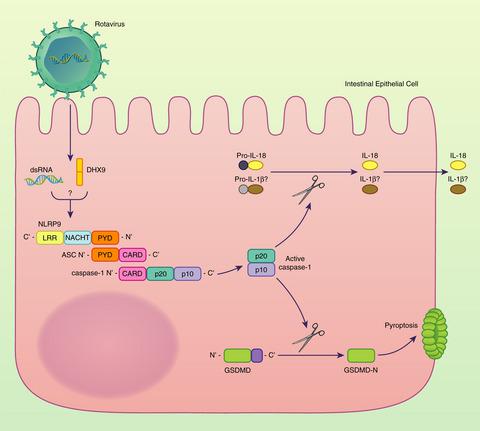当前位置:
X-MOL 学术
›
Immunology
›
论文详情
Our official English website, www.x-mol.net, welcomes your
feedback! (Note: you will need to create a separate account there.)
NLRP9 in innate immunity and inflammation
Immunology ( IF 4.9 ) Pub Date : 2020-12-06 , DOI: 10.1111/imm.13290 Breanne Mullins 1 , Jueqi Chen 1
Immunology ( IF 4.9 ) Pub Date : 2020-12-06 , DOI: 10.1111/imm.13290 Breanne Mullins 1 , Jueqi Chen 1
Affiliation

|
The nucleotide‐binding domain leucine‐rich repeat containing receptors (NLRs) are a family of evolutionarily conserved proteins. Several members of NLRs, notably NLRP1, NLRP3 and NLRC4, are able to form cytosolic oligomeric signalling platforms termed inflammasomes to mediate immune response towards pathogens, damage and stress. However, the functions of many NLRs still remain elusive. In the past few years, a couple of less‐characterized NLR members are emerging as important signalling molecules with fundamental functions in host defence and inflammation. Among them, NLRP9 is an NLR originally proposed to be expressed and function solely in the reproductive system. Recent evidence has suggested that NLRP9 is also capable of initiating inflammasome formation in the intestine to restrict replication and damage brought by rotavirus infection. Here, we highlight the latest progress in characterization of the role of NLRP9 in infectious and inflammatory diseases, as well as the newest crystallographic and biochemical studies on NLRP9. Finally, we discuss some important questions remained to be answered regarding the molecular and cellular mechanisms governing NLRP9's function in innate immunity and inflammation.
中文翻译:

NLRP9 在先天免疫和炎症中
核苷酸结合结构域富含亮氨酸重复序列的受体 (NLR) 是进化上保守的蛋白质家族。NLR 的几个成员,特别是 NLRP1、NLRP3 和 NLRC4,能够形成称为炎性体的胞质寡聚信号平台,以介导对病原体、损伤和压力的免疫反应。然而,许多 NLR 的功能仍然难以捉摸。在过去的几年里,一些不太知名的 NLR 成员正在成为重要的信号分子,在宿主防御和炎症中具有基本功能。其中,NLRP9是最初提出仅在生殖系统中表达和发挥作用的NLR。最近的证据表明,NLRP9 还能够在肠道中启动炎性体形成,以限制轮状病毒感染带来的复制和损害。这里,我们重点介绍了 NLRP9 在传染病和炎症性疾病中作用的最新进展,以及对 NLRP9 的最新晶体学和生化研究。最后,我们讨论了一些关于控制 NLRP9 在先天免疫和炎症中的功能的分子和细胞机制仍有待回答的重要问题。
更新日期:2020-12-06
中文翻译:

NLRP9 在先天免疫和炎症中
核苷酸结合结构域富含亮氨酸重复序列的受体 (NLR) 是进化上保守的蛋白质家族。NLR 的几个成员,特别是 NLRP1、NLRP3 和 NLRC4,能够形成称为炎性体的胞质寡聚信号平台,以介导对病原体、损伤和压力的免疫反应。然而,许多 NLR 的功能仍然难以捉摸。在过去的几年里,一些不太知名的 NLR 成员正在成为重要的信号分子,在宿主防御和炎症中具有基本功能。其中,NLRP9是最初提出仅在生殖系统中表达和发挥作用的NLR。最近的证据表明,NLRP9 还能够在肠道中启动炎性体形成,以限制轮状病毒感染带来的复制和损害。这里,我们重点介绍了 NLRP9 在传染病和炎症性疾病中作用的最新进展,以及对 NLRP9 的最新晶体学和生化研究。最后,我们讨论了一些关于控制 NLRP9 在先天免疫和炎症中的功能的分子和细胞机制仍有待回答的重要问题。











































 京公网安备 11010802027423号
京公网安备 11010802027423号